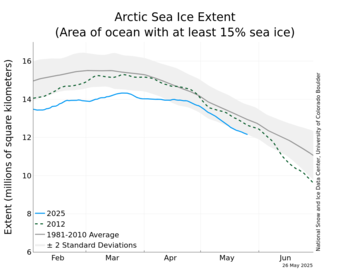Once again you don't have a fucking clue what you're talking about. Once again you don't have a fucking clue what you're talking about [/COLOR][/SIZE][/FONT]
History of the Ozone Hole
Throughout the 20th century, discoveries and observations trickled in that would allow scientists to understand how human-made chemicals like chlorofluorocarbons create a hole in the ozone layer over Antarctica each spring.
As early as 1912, Antarctic explorers recorded observations of unusual veil-type clouds in the polar stratosphere, although they could not have known at the time how significant those clouds would become. In 1956, the British Antarctic Survey set up the Halley Bay Observatory on Antarctica in preparation for the International Geophysical Year (IGY) of 1957. In that year, ozone measurements using a Dobson Spectrophotometer began.
Instruments on the ground (at Halley) and high above Antarctica (the Total Ozone Mapping Spectrometer [TOMS] and Ozone Monitoring Instrument [OMI]) measured an acute drop in total atmospheric ozone during October in the early and middle 1980s. (Halley data supplied by J. D. Shanklin, British Antarctic Survey ).
These measurements gave the first clues that there was trouble in the ozone layer. In 1985, a group of scientists (J. C. Farman, B. G. Gardiner, and J. D. Shanklin) published in the journal Nature the first paper on observations of springtime losses of ozone over Antarctica. In 1986, NASA scientists used satellite data from the Total Ozone Mapping Spectrometer (TOMS) and the Solar Backscatter Ultraviolet (SBUV) instrument to demonstrate that the ozone hole is a regional-scale Antarctic phenomenon.
Between 1986 and 1987, several papers suggested possible mechanisms for the ozone hole, including chemical, dynamical (meteorological), and solar cycle influences. Among the key papers explaining the atmospheric chemistry of CFCs and ozone depletion was one by Susan Solomon and several colleagues. The paper also emphasized the need for polar stratospheric clouds to explain the reaction chemistry. Also in 1986, Michael B. McElroy and colleagues described a role for bromine in ozone-depleting reactions. Paul Crutzen and Frank Arnold proposed that the polar stratospheric clouds could be made of nitric acid trihydrate, which would explain the clouds’ presence at an altitude and temperature that should not have been cold enough for the tiny amount of pure water vapor present in the stratosphere to condense.
Observational evidence of the role of chlorine in ozone loss continued to mount during that same period. For example, the National Ozone Expedition (NOZE) measured elevated levels of the chemical chlorine dioxide (OClO) during the springtime ozone hole from McMurdo Research Station. Then in 1987, the Antarctic Airborne Ozone Expedition flew the ER-2 and DC-8 research aircraft from Punta Arenas, Chile, into the Antarctic Vortex.
Aircraft measurements in the late 1980s confirmed the link between CFCs, chlorine, and ozone loss. Here a NASA ER-2 high-altitude research aircraft lifts off from Kiruna, Sweden on a mission to study Arctic ozone. (NASA Dryden Flight Research Center photo EC00-0037-22)
The aircraft observations produced the “smoking gun” linking CFC-derived chlorine to the ozone hole. The flight data showed a negative correlation between chlorine monoxide (ClO) and ozone: the higher the concentration of ClO, the lower the concentration of ozone. In 1988, the husband and wife team Mario and Luisa Molina described the chemical reactions through which ClO catalyzes the extremely rapid destruction of ozone.
NASA has been monitoring the status of the ozone layer through satellite observations since the 1970s, beginning with the TOMS sensors on the Nimbus satellites. The latest-generation ozone-monitoring technology, the Ozone Monitoring Instrument (OMI), is flying onboard NASA’s Aura satellite.
http://ozonewatch.gsfc.nasa.gov/facts/history_SH.html Originally Posted by Munchmasterman
ManMuncher... Talking shit... about his 0hole... ManMuncher needs to get his head right...
https://wattsupwiththat.com/2016/05/...for-the-pause/

*Yes, the Atmospheric “Greenhouse” effect is real. It is responsible for the Earth being about 33⁰C (60⁰F) warmer than it would be absent “Greenhouse” gasses in the Atmosphere.
*Yes Carbon Dioxide (CO2) is a key “Greenhouse” gas, second only to Water Vapor (H2O).
*Yes CO2 has increased by about a third during the past century (from 300 to 400 parts per million), mostly due to unprecedented burning of large quantities of coal, oil, and natural gas.
*Yes, temperatures have gone up by about 0.8⁰C (1.5⁰F) over the past century.
*HOWEVER, warming is mostly natural and due to Earth’s recovery from the depths of the last ice age, some 18,000 years ago.
*No matter what we do, the Earth will warm for hundreds or thousands of years, then plunge into the next ice age. Of course this will not happen monotonically. There will be multi-decade periods of warming and of cooling, just as the Medieval Warm Period (1000-1200s) was considerably warmer than today, and the Little Ice Age (1600-1700s) was colder.
*IPCC climate theory and computer models have failed to match actual satellite temperature data. Alarming predictions have not come to pass. They totally missed the statistical warming “Pause” of the early 2000s. [The IPCC is the Intergovernmental Panel on Climate Change]
*[See the lower right section of the figure] For several periods, even the lowest edge of the Yellow error band is warmer than the highest edge of the Blue band! [These error bands are 5%-95% statistical confidence limits, which means there is less than 1 chance in 20 any point outside a band is due to random error. Thus, there is less than 1 chance in 20 x 20 = 400 that any point in the White space between the Yellow and Blue bands is due to random error. Either the NASA satellite sensor systems are badly out of order or the IPCC climate models are terribly wrong!]
*The gross failure of the IPCC models to correctly predict warming, despite a significant increase in CO2, proves that the models, and the underlying IPCC climate theories, are wrong.
*The most generous explanation is that the IPCC climate scientists simply over-estimated the sensitivity of climate to CO2 increase by a factor of two to three.
*The most likely explanation is that their climate theory is either incomplete or totally wrong, so their models failed. Either that, or, for political purposes, they purposely jiggered the model parameters to create alarming projections and keep research funding coming from we taxpayers to their organizations.


